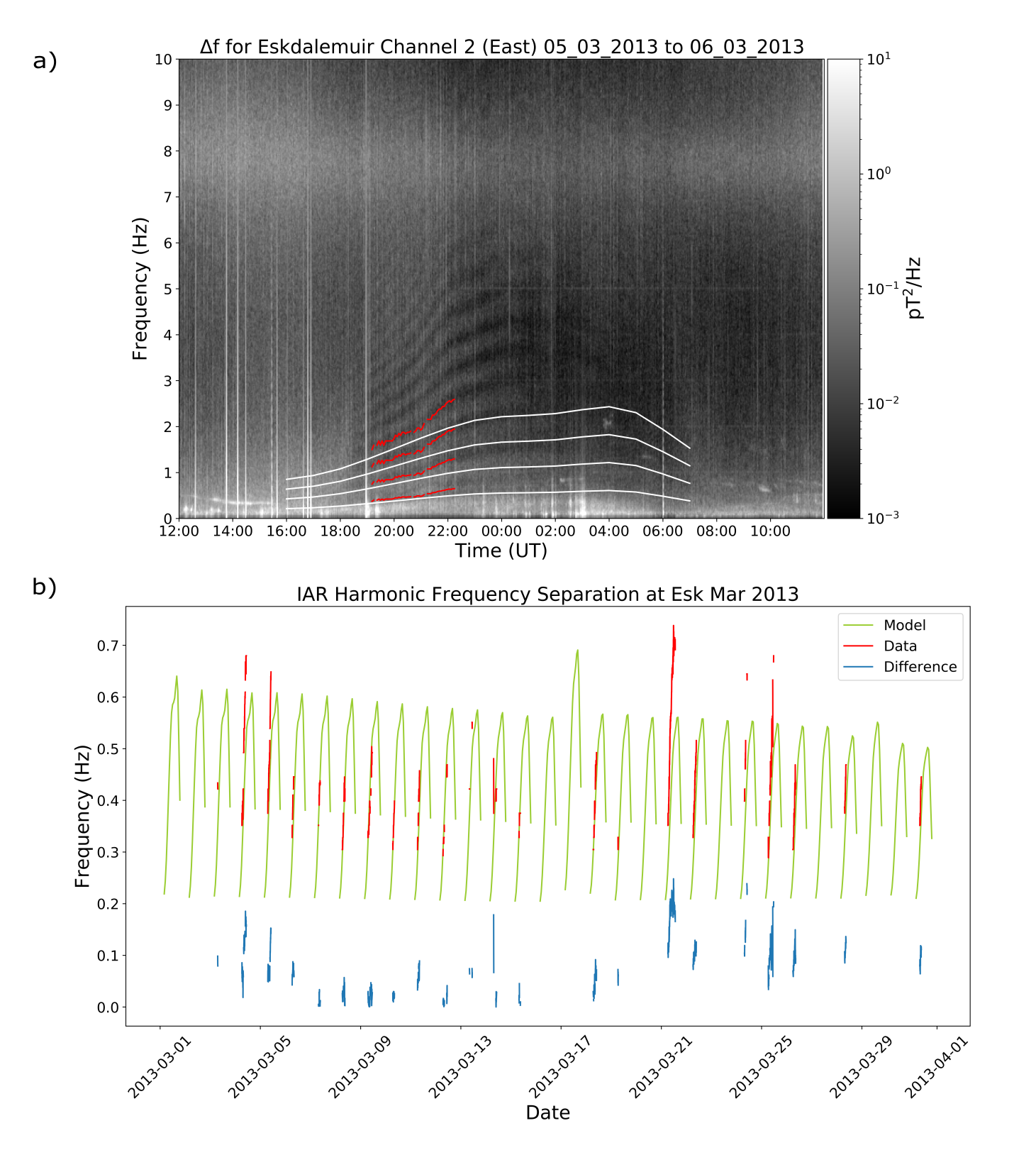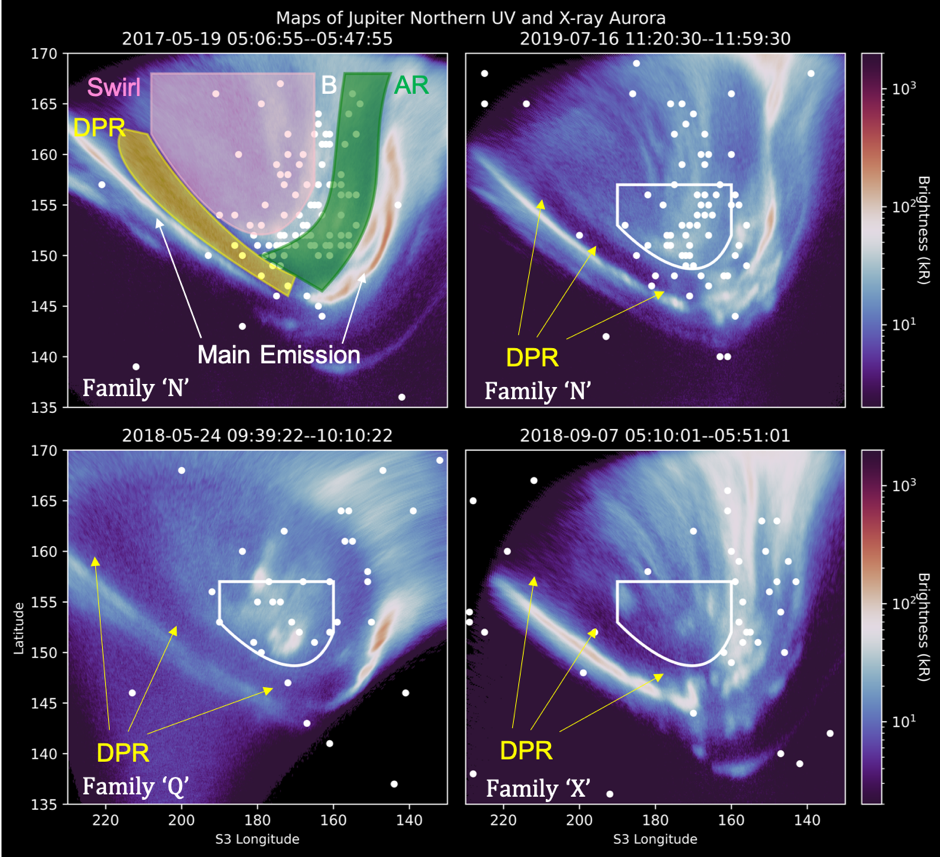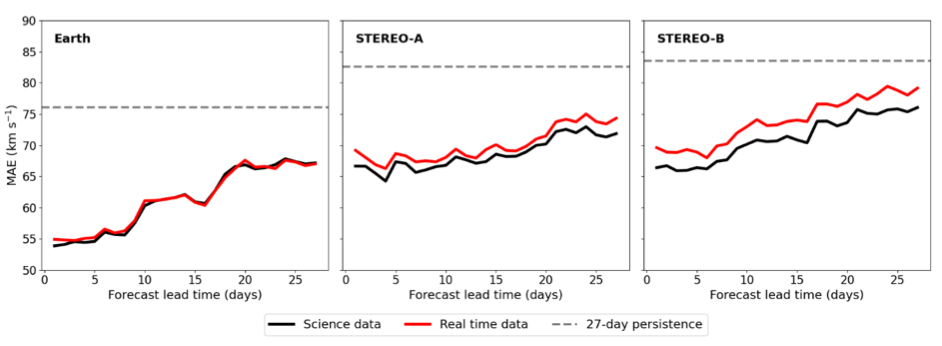MIST
Magnetosphere, Ionosphere and Solar-Terrestrial
Nuggets of MIST science, summarising recent papers from the UK MIST community in a bitesize format.
If you would like to submit a nugget, please fill in the following form: https://forms.gle/Pn3mL73kHLn4VEZ66 and we will arrange a slot for you in the schedule. Nuggets should be 100–300 words long and include a figure/animation. Please get in touch!
If you have any issues with the form, please contact This email address is being protected from spambots. You need JavaScript enabled to view it..
Filling in the gaps in the UK magnetic field coverage
Ciaran Beggan (British Geological Survey)
Monitoring the ground magnetic field variation during space weather events, such as geomagnetic storms, is important for understanding and modelling their potentially hazardous effects on power, rail, and pipeline systems. The UK has three geomagnetic observatories in Lerwick, Eskdalemuir and Hartland. These form an approximately north-south line in latitude but have little variation in longitude. To expand the coverage in the east-west directions, as part of the SWIMMR N4 project, the British Geological Survey geomagnetism team have installed three new variometer stations in Northern Ireland, Leicestershire, and Sussex (Figure 1, left). These systems consist of a three-axis vector fluxgate magnetometer, a digitiser/logger computer and a 4G modem to transmit near-real-time data. The systems use batteries and a solar panel for independent power supply (Figure 1, centre).
Two systems were installed in fields in rural areas, at Florence Court (FLO) National Trust and near Market Harborough (LEI) while the third is located at the Space Geodesy Facility in Herstmonceux (HTX). The magnetic data quality is good and suitable for space weather monitoring purposes. The three new variometers fill in the ‘gaps’ between the BGS and other INTERMAGNET observatories reducing the inter-site distance to less than 400 km (Figure 1, right), thus improving the overall coverage.
The variometers will run for two years initially as part of the SAGE project to enhance geoelectric field modelling capabilities in the UK.

The Harmonic Frequency Separation of Ionospheric Alfvén Resonances at Eskdalemuir
Rosie Hodnett (University of Leicester)
Ionospheric Alfvén resonances (IAR) occur when Alfvén waves are partially reflected at boundaries in the ionosphere where there are large changes in plasma mass density. These boundaries are the bottom of the ionosphere and above the F-Region peak. This sets up a resonance (Belyaev et al., 1990).
IAR have been observed in the induction coil magnetometer data at Eskdalemuir Geophysical Observatory, which is a British Geological Survey site (Beggan & Musur, 2018).
We have modelled the harmonic frequency separation (Δf) of the IAR, by modelling the Alfvén velocity and calculating the time taken for the wave to travel up and down the IAR cavity. We used the International Reference Ionosphere to model the plasma mass density and the International Geomagnetic Reference Field to model the magnetic field strength.
To find the average Δf from the data, we used machine learning to identify the IAR harmonics in spectrograms, and then automatically extracted the frequencies. We used a u-net (Ronneberger et al., 2015) which was developed by Marangio et al. (2020) to detect the IAR.
Figure a) shows the spectrogram for 05/03/2013 – 06/03/2013. The IAR harmonics are visible as bright fringes. The red line lowest in frequency is the average Δf extracted from the data, with subsequent red lines being 2 x Δf, 3 x Δf and 4 x Δf. These are plotted so we can see the Δf following the trends of the harmonics. The lowest white line is the modelled Δf, with higher white lines being higher orders. Generally, the model agrees fairly well with the data. Here, both the data and the model show Δf increasing from dusk to midnight. The data diverges from the model later on, indicating that the model does not accurately capture the ionosphere at this time.
Figure (b) shows the modelled Δf in green, Δf from the data in red and the absolute difference between them in blue, for March 2013. Overall, the data and the model agree well. On 21/03/2013, there is a greater difference between the model and data than other days. Examples like this will be investigated further.
We are now performing further analysis of the 9 year dataset, including a comparison of the data and model to foF2, sunspot number, Sym-H and Kp.

References:
Beggan, C. D., & Musur, M. (2018). Observation of Ionospheric Alfvén Resonances at 1-30 Hz and their Superposition with the Schumann Resonances. Journal of Geophysical Research: Space Physics, 123 (5), 4202–4214. doi: 10.1029/2018ja025264
Belyaev, P., Polyakov, S., Rapoport, V., & Trakhtengerts, V. (1990). The Ionospheric Alfvén Resonator. Journal of Atmospheric and Terrestrial Physics, 52 (9), 781–788. doi: 10.1016/0021-9169(90)90010-k
Marangio, P., Christodoulou, V., Filgueira, R., Rogers, H. F., & Beggan, C. D. (2020). Automatic Detection of Ionospheric Alfvén Resonances in Magnetic Spectrograms using U-Net. Computers amp; Geosciences, 145 , 104598. doi:10.1016/j.cageo.2020.104598
Ronneberger, O., Fischer, P., & Brox, T. (2015). U-Net: Convolutional Networks for Biomedical Image Segmentation. Lecture Notes in Computer Science, 234–241. doi:10.1007/978-3-319-24574-4 287
Acknowledgements:
BGS: www.geomag.bgs.ac.uk/operations/eskdale.html
IRI: www.irimodel.org
IGRF: https://www.ngdc.noaa.gov/IAGA/vmod/igrf.html
Jupiter’s X-Ray and UV Dark Polar Region
By Daisy May and Ben Sipos (St Gilgen’s School)
Jupiter produces powerful ultraviolet (UV) and X-ray aurorae at the planet’s poles. The emissions take on a variety of dynamic structures, particularly in the swirl and active regions (Figure 1). However, the dark polar region (DPR) consistently demonstrates a lack of auroral emissions. 14 simultaneous Chandra X-ray Observatory and Hubble Space Telescope observations of Jupiter’s Northern aurorae (between 2016 and 2019) revealed that no statistically significant X-ray signature is detectable within the DPR.
There were two potential non-DPR sources that might have contributed DPR photons, that needed to be considered. The first source was scattered solar photons. By shifting a region the same shape and size as the observed DPR across non-auroral longitudes of the planet, and scaling the photon counts to the duration of the HST observation, we determined the expected number of scattered photons in the DPR for each observation (0.3 to 1.4 counts depending on the DPR size, distance to Jupiter, and solar activity).
The second source was emissions perceived to have come from within the DPR due to the spatial uncertainty of the X-ray Observatory. To determine the count of such photons, we simulated where photons that were produced from the active and swirl regions would have been detected when passed through the spatial uncertainties applied by the X-ray observatory. After 100,000 simulations for each observation, we determined the count of such falsely detected photons, and found that there is no statistically significant X-ray detection from the DPR for these 14 observations.
The lack of x-rays implies low levels of precipitation by solar wind and energetic magnetospheric ions in the DPR. Therefore, the observations are consistent with the DPR being associated with either: Jupiter’s open field line region and/or the DPR containing different potential drops or an absence of the strong downward currents and/or wave-particle interactions present across the rest of the polar aurorae.
This research project was undertaken with the Orbyts programme which partners scientists with schools to support school student involvement in research and to improve inclusivity in science. This nugget was written by two school students who produced a significant proportion of the work in the associated paper.

Figure 1: Overlaid simultaneous UV (blue-white-red color map) and X-ray photon (white dots) longitude-latitude maps of Jupiter's North Pole, from the Hubble Space Telescope (HST) and Chandra X-ray Observatory High Resolution Camera (CXO-HRC). Dates and times of the observations (UT) are at the top of each panel. Only UV and X-ray emissions produced during this time window are shown. Jupiter’s main emission is labelled by white arrows, the dark polar region (DPR) is shown in yellow, the Swirl region is shown in pink and the Active Regions (sometimes split into a noon and dusk active region) are shown in Green. The boundary between the active region and swirl region (here labelled with a white “B”) sometimes includes an arc of UV and X-ray emission, as is the case for the two different observations shown in the top two panels here. The other panels highlight three different UV aurora families, as indicated by the white label in the lower left corner of each (Grodent et al. 2018). The white shape overlaid onto each map is consistent across each, and highlights the changing spatial distribution of X-rays for each. For each panel, the location and extent of the DPR are indicated with yellow arrows, showcasing its changing extent from observation-to-observation.
References: Grodent, D., Bonfond, B., Yao, Z., Gérard, J.-C., Radioti, A., Dumont, M., et al. (2018). Jupiter’s aurora observed with HST during Juno orbits 3 to 7. Journal of Geophysical Research: Space Physics, 123(5), 3299– 3319.
Associated Paper: Dunn, W.R., Weigt, D.M., Grodent, D., Yao, Z.H., May, D., Feigelman, K., Sipos, B., Fleming, D., McEntee, S., Bonfond, B. and Gladstone, G.R., 2022. Jupiter’s X‐ray and UV Dark Polar Region. Geophysical Research Letters, p.e2021GL097390.
Data Assimilation and the Solar Wind
By Harriet Turner (University of Reading)
Data assimilation (DA) combines model output and observations to form an optimal estimation of reality. It has led to large improvements in terrestrial weather prediction, reducing the “butterfly effect”, by which small errors in the initial conditions can grow non-linearly and lead to large errors in the subsequent forecast.
DA has been used in three main areas for space weather forecasting: the ionosphere, the photosphere, and, more recently, the solar wind. The first attempts at using DA for solar wind forecasting has shown promise, with a reduction in forecast error (Lang, 2021).
I have been using the Burger Radius Variational Data Assimilation (BRaVDA) scheme (Lang, 2019). This uses output from a coronal model with a computationally efficient solar wind model (HUX; Riley and Lionello, 2011) to map information from in-situ observations at Earth’s orbital radius (215 solar radii), back to the HUX inner boundary at 30 solar radii. The inner boundary conditions are then updated, given the information from the in-situ observations. This update is then run forward in time, again using HUX, to produce a reconstruction of the solar wind. This can then be used for forecasting.
We have three sources of observations: STEREO-A, STEREO-B, and the OMNI dataset for near-Earth space. For the purposes of my work, I am using a simple corotation to produce a forecast. We can compare this forecast against observations from the three sources to assess its performance. Recently, I have been looking at testing the performance of BRaVDA with real time data. Previous experiments have used cleaned-up, science-level data, but real time data would need to be used for an operational DA scheme. Initial results show that using the real time data does not worsen the forecasts significantly and is still an improvement from a 27-day persistence forecast, as shown in Figure 1, which is promising for future implementation of solar wind DA.

Figure 1: Mean absolute error (MAE) of solar wind forecasts as a function of forecast lead time, for the case where OMNI, STEREO-A and STEREO-B observations are assimilated together. The black line shows the forecast where the science-level data was used and the red line when real time data was used. The dashed grey line shows the average 27-day persistence MAE for the specific spacecraft. The left-hand panel shows the forecast at Earth, the middle panel shows the forecast at STEREO-A and the right-hand panel shows the forecast at STEREO-B. This covers the period from 01/04/2012 to 01/10/2013.
References:
Lang, M., & Owens, M. J. (2019). A Variational Approach to Data Assimilation in the Solar Wind. Space Weather, 17(1), 59 – 83. Doi: 10.1029/2018SW001857.
Lang, M., Witherington, J., Owens, M. J., & Turner, H. (2021). Improving solar wind forecasting using data assimilation. Space Weather, 1 – 23.
Riley, P., & Lionello, R. (2011). Mapping Solar Wind Streams from the Sun to 1 AU: A Comparison of Techniques. Solar Physics, 270(2), 575 – 592. Doi: 10.1007/s11207-001-9766-x.
Assessing the Impact of Weak and Moderate Geomagnetic Storms on UK Power Station Transformers
By Zoë Lewis (Imperial College London)
Geomagnetically induced currents (GICs) are known to cause damage to power station transformers, as they can flow through the grounded neutral and generate extra magnetic flux, causing localised heating. This heating can break down the insulation and cooling oil that surrounds the core, so can be measured through small changes in the concentrations of dissolved gases within the oil.
In this work, we analysed dissolved gas data from 13 UK based transformers during geomagnetic storms from 2010-2015. We used a list of storms outlined in [1] and looked for an increase in the levels of carbon monoxide, hydrogen, and methane at the onset of the storm, as well as any correlation between the rate of gas increase and the SYM-H index. We also used the Low Energy Degradation Triangle (LEDT) method [2] as a measure of degradation.
Figure 1 shows the results of a superposed epoch analysis (SEA) for carbon monoxide, methane and hydrogen in one transformer. The epochs are centred on the start of the main phase of each storm, as defined in [1]. There is no systematic increase in the gas concentrations at the storm onset or in the following days. The interquartile range (shaded blue) is also very large owing to the highly variable data.
We conclude that during this period, the transformers studied were unaffected by space weather events. However, it is noted that 2010-2015 lies within a relatively quiet solar cycle, and there were no storms in this period that would be considered large on the scale of the past few decades. Therefore, in future work it would be desirable to expand this study to look at a more geomagnetically active period.

[1] Walach, M. T., & Grocott, A. (2019). SuperDARN Observations During Geomagnetic Storms, Geomagnetically Active Times, and Enhanced Solar Wind Driving. Journal of Geophysical Research: Space Physics, 124 (7), 5828–5847. doi: 10.1029/2019JA026816
[2] Moodley, N., & Gaunt, C. T. (2017). Low Energy Degradation Triangle for power transformer health assessment. IEEE Transactions on Dielectrics and Electrical Insulation, 24 (1), 639–646. doi: 10.1109/TDEI.2016.006042
Please see paper for full details: , , , & (2022). Assessing the impact of weak and moderate geomagnetic storms on UK power station transformers. Space Weather, 20, e2021SW003021. https://doi.org/10.1029/2021SW003021